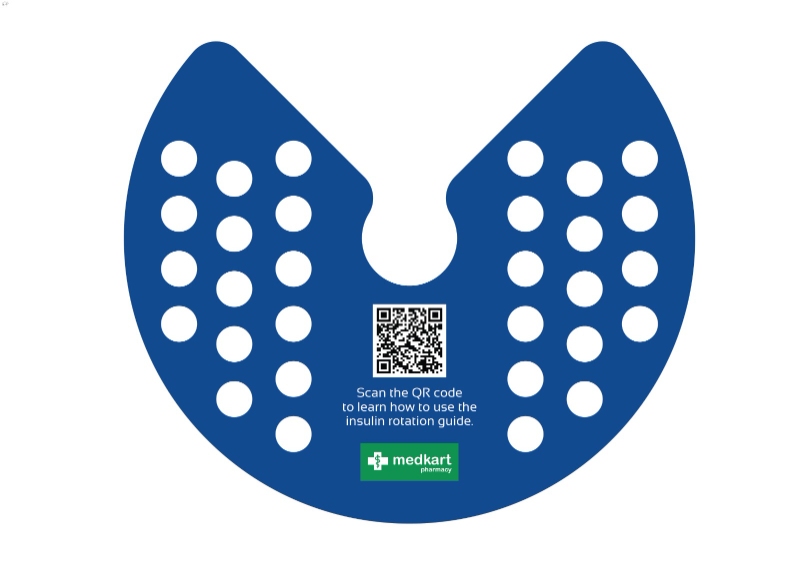Last updated on December 26th, 2024 at 03:47 pm

For individuals with diabetes who require insulin injections, proper injection site rotation is crucial for maintaining effective treatment and avoiding potential complications. At Medkart, we recognize the significance of recording the injection site and promoting site rotation as part of the Medication Management System.
Our newly introduced Insulin Site Rotation Label offers a convenient way to track and manage injection sites on a body map within the Medication Chart. This blog will discuss the importance of insulin rotation, and its advantages, and provide helpful tips for successful site rotation.
Steps to use Medkart’s Insulin site rotation guide
English:
Step 1 – Get the insulin ready for injecting.
Step 2 – Place the rotation guide such that centre of the circle is at the navel.
Step 3 – Next, select the day of the month for the injection.
Hindi:
स्टेप 1 – इंजेक्शन के लिए इंसुलिन तैयार करें।
स्टेप 2 – रोटेशन गाइड को ऐसे रखें की उसका केंद्र नाभि पर हो।
स्टेप 3 – फिर, इंजेक्शन के लिए महीने का उचित दिन चुनें।
Gujarati:
સ્ટેપ 1 – ઇન્જેક્શન માટે ઇન્સ્યુલિન તૈયાર કરો.
સ્ટેપ 2 – રોટેશન ગાઇડને એવી રીતે મૂકો કે જેથી તેનું કેન્દ્ર નાભિ પર હોય.
સ્ટેપ 3 – પછી, ઈન્જેક્શન માટે મહિનાનો યોગ્ય દિવસ પસંદ કરો.
> Consult a doctor and Order Medicine Online.
Importance of Insulin Site Rotation
Preventing Lipohypertrophy: Lipohypertrophy refers to the accumulation of fatty tissue at injection sites. Regularly injecting insulin in the same area can lead to this condition, which affects insulin absorption and blood glucose control. By rotating injection sites, you can reduce the risk of developing lipohypertrophy.

Enhancing Insulin Absorption: Injection site rotation helps maintain consistent insulin absorption rates. Different areas of the body have varying rates of insulin absorption, and rotating sites ensure that insulin is delivered effectively, leading to more predictable blood glucose levels.
Advantages of Insulin Site Rotation
Improved Insulin Absorption: When injection sites are rotated, the body has a chance to recover from the previous injection. This allows for better insulin absorption, ensuring that the medication functions optimally and maintains glucose control.
Reduced Risk of Complications: Lipohypertrophy not only affects insulin absorption but can also cause unpredictable blood glucose levels and insulin resistance. By practising proper site rotation, you minimize the risk of developing complications associated with lipohypertrophy.
Increased Injection Site Options: Regularly rotating injection sites expand the available areas for administering injections. This offers more flexibility and comfort for patients, as they can choose different locations while still maintaining the effectiveness of their treatment.
Read: What is Autism spectrum disorder?
Tips for Successful Insulin Site Rotation
Follow the Medkart Insulin Site Rotation Guide: Place the Medkart Insulin site rotation guide on your body, aligning the centre of the circle with your navel. This guide will help you accurately record and track the injection sites on the body map within your Medication Chart.

Rotate Injection Sites and Areas: It is important to vary both the injection sites (such as the abdomen, thigh, buttock, or upper arm) and the specific areas within those sites. This helps distribute the impact of injections across different regions, reducing the risk of lipohypertrophy.
Regularly Check for Lipohypertrophy: Stay vigilant and monitor your injection sites for any signs of lipohypertrophy, such as lumps, bumps, or changes in the skin’s texture. If you notice any anomalies, promptly contact your physician for evaluation and guidance.
Conclusion:
Insulin site rotation is an essential practice for diabetic patients who rely on insulin injections to manage their condition. By using the Medkart Insulin Site Rotation Guide and adhering to proper rotation techniques, you can promote effective insulin absorption, reduce the risk of complications like lipohypertrophy, and maintain predictable blood glucose levels. Remember to consult with your healthcare provider for personalized guidance on insulin injection site rotation. With careful management and adherence to best practices, you can ensure the success of your insulin therapy and lead a healthy life with diabetes.
Also Read:
- How to cure Sinus Headache with Home Remedies
- Conjunctivitis Symptom
- Skin Allergy
- Hemorrhagic Ovarian Cysts
FAQs on Insulin Injection Sites
Q.1. How often to change the Insulin Pump Site?
To maintain proper insulin delivery and minimize complications, it’s advisable to change insulin pump sites approximately every 2-3 days. Keep in mind that individual routines might differ.
Q.2. Where can I put my Insulin Pump Site?
You can position your insulin pump site in regions containing fatty tissue like the abdomen, thighs, or buttocks, ensuring rotation to prevent irritation.
For access to more such interesting articles on healthcare, visit Medkart today!

